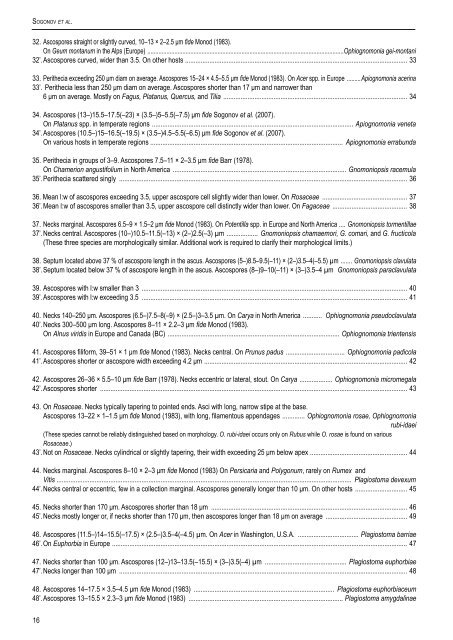Leaf-inhabiting genera of the Gnomoniaceae, Diaporthales - CBS
Leaf-inhabiting genera of the Gnomoniaceae, Diaporthales - CBS
Leaf-inhabiting genera of the Gnomoniaceae, Diaporthales - CBS
Create successful ePaper yourself
Turn your PDF publications into a flip-book with our unique Google optimized e-Paper software.
So g o n o v e t a l.<br />
32. Ascospores straight or slightly curved, 10–13 × 2–2.5 μm fide Monod (1983).<br />
On Geum montanum in <strong>the</strong> Alps (Europe) ...........................................................................................................................Ophiognomonia gei-montani<br />
32’. Ascospores curved, wider than 3.5. On o<strong>the</strong>r hosts ................................................................................................................................ 33<br />
33. Peri<strong>the</strong>cia exceeding 250 μm diam on average. Ascospores 15–24 × 4.5–5.5 μm fide Monod (1983). On Acer spp. in Europe ..........Apiognomonia acerina<br />
33’. Peri<strong>the</strong>cia less than 250 μm diam on average. Ascospores shorter than 17 μm and narrower than<br />
6 μm on average. Mostly on Fagus, Platanus, Quercus, and Tilia ........................................................................................................... 34<br />
34. Ascospores (13–)15.5–17.5(–23) × (3.5–)5–5.5(–7.5) μm fide Sogonov et al. (2007).<br />
On Platanus spp. in temperate regions ..................................................................................................................... Apiognomonia veneta<br />
34’. Ascospores (10.5–)15–16.5(–19.5) × (3.5–)4.5–5.5(–6.5) μm fide Sogonov et al. (2007).<br />
On various hosts in temperate regions ............................................................................................................... Apiognomonia errabunda<br />
35. Peri<strong>the</strong>cia in groups <strong>of</strong> 3–9. Ascospores 7.5–11 × 2–3.5 μm fide Barr (1978).<br />
On Chamerion angustifolium in North America ..................................................................................................... Gnomoniopsis racemula<br />
35’. Peri<strong>the</strong>cia scattered singly ....................................................................................................................................................................... 36<br />
36. Mean l:w <strong>of</strong> ascospores exceeding 3.5, upper ascospore cell slightly wider than lower. On Rosaceae .................................................. 37<br />
36’. Mean l:w <strong>of</strong> ascospores smaller than 3.5, upper ascospore cell distinctly wider than lower. On Fagaceae ............................................ 38<br />
37. Necks marginal. Ascospores 6.5–9 × 1.5–2 μm fide Monod (1983). On Potentilla spp. in Europe and North America .... Gnomoniopsis tormentillae<br />
37’. Necks central. Ascospores (10–)10.5–11.5(–13) × (2–)2.5(–3) µm ................... Gnomoniopsis chamaemori, G. comari, and G. fructicola<br />
(These three species are morphologically similar. Additional work is required to clarify <strong>the</strong>ir morphological limits.)<br />
38. Septum located above 37 % <strong>of</strong> ascospore length in <strong>the</strong> ascus. Ascospores (5–)8.5–9.5(–11) × (2–)3.5–4(–5.5) µm ....... Gnomoniopsis clavulata<br />
38’. Septum located below 37 % <strong>of</strong> ascospore length in <strong>the</strong> ascus. Ascospores (8–)9–10(–11) × (3–)3.5–4 µm . Gnomoniopsis paraclavulata<br />
39. Ascospores with l:w smaller than 3 .......................................................................................................................................................... 40<br />
39’. Ascospores with l:w exceeding 3.5 .......................................................................................................................................................... 41<br />
40. Necks 140–250 μm. Ascospores (6.5–)7.5–8(–9) × (2.5–)3–3.5 µm. On Carya in North America ............ Ophiognomonia pseudoclavulata<br />
40’. Necks 300–500 μm long. Ascospores 8–11 × 2.2–3 μm fide Monod (1983).<br />
On Alnus viridis in Europe and Canada (BC) .................................................................................................... Ophiognomonia trientensis<br />
41. Ascospores filiform, 39–51 × 1 μm fide Monod (1983). Necks central. On Prunus padus .................................. Ophiognomonia padicola<br />
41’. Ascospores shorter or ascospore width exceeding 4.2 μm ..................................................................................................................... 42<br />
42. Ascospores 26–36 × 5.5–10 μm fide Barr (1978). Necks eccentric or lateral, stout. On Carya ................... Ophiognomonia micromegala<br />
42’. Ascospores shorter .................................................................................................................................................................................. 43<br />
43. On Rosaceae. Necks typically tapering to pointed ends. Asci with long, narrow stipe at <strong>the</strong> base.<br />
Ascospores 13–22 × 1–1.5 μm fide Monod (1983), with long, filamentous appendages ............. Ophiognomonia rosae, Ophiognomonia<br />
rubi-idaei<br />
(These species cannot be reliably distinguished based on morphology. O. rubi-idaei occurs only on Rubus while O. rosae is found on various<br />
Rosaceae.)<br />
43’. Not on Rosaceae. Necks cylindrical or slightly tapering, <strong>the</strong>ir width exceeding 25 μm below apex ........................................................ 44<br />
44. Necks marginal. Ascospores 8–10 × 2–3 μm fide Monod (1983) On Persicaria and Polygonum, rarely on Rumex and<br />
Vitis .......................................................................................................................................................................... Plagiostoma devexum<br />
44’. Necks central or eccentric, few in a collection marginal. Ascospores <strong>genera</strong>lly longer than 10 μm. On o<strong>the</strong>r hosts ............................... 45<br />
45. Necks shorter than 170 μm. Ascospores shorter than 18 μm .................................................................................................................. 46<br />
45’. Necks mostly longer or, if necks shorter than 170 μm, <strong>the</strong>n ascospores longer than 18 μm on average ................................................ 49<br />
46. Ascospores (11.5–)14–15.5(–17.5) × (2.5–)3.5–4(–4.5) µm. On Acer in Washington, U.S.A. .................................... Plagiostoma barriae<br />
46’. On Euphorbia in Europe .......................................................................................................................................................................... 47<br />
47. Necks shorter than 100 μm. Ascospores (12–)13–13.5(–15.5) × (3–)3.5(–4) µm ................................................ Plagiostoma euphorbiae<br />
47’. Necks longer than 100 μm ....................................................................................................................................................................... 48<br />
48. Ascospores 14–17.5 × 3.5–4.5 μm fide Monod (1983) .................................................................................. Plagiostoma euphorbiaceum<br />
48’. Ascospores 13–15.5 × 2.3–3 μm fide Monod (1983) .......................................................................................... Plagiostoma amygdalinae<br />
16

















